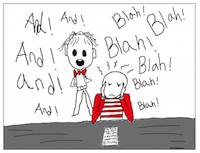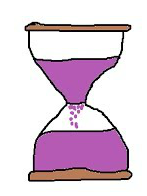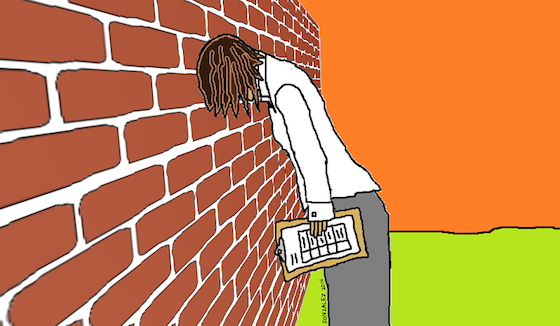10 Ways to Sabotage Your Classroom Management

You know the basics: Establish clear rules and consequences, be consistent, keep students engaged. But even with all that in place, the small things you do could be wreaking havoc on your whole system.
Here are some habits you might have developed that are messing with your classroom management, along with more effective alternatives.
1. Smiling at the Wrong Times
This was a big problem for me. I thought my students were pretty funny people, so when a kid took those first steps to get us off-track, I couldn’t help but smile. And that just encouraged him to continue. The irony was that five minutes later, I would be yelling at the whole class for getting too wild. Duh.
Alternative: Make a conscious effort to hold a neutral, “on-task” facial expression when you need your class to be focused. I still think it’s important to show students you have a sense of humor and appreciate theirs, but everyone needs to learn that there’s a time and place for it. Have a private conversation with your class clowns, letting them know that there will be times when you won’t react to their jokes – that will be your signal that it’s a “serious” time.
2. Handling Problems Publicly
Addressing student misbehavior in a public way risks embarrassing the student, and if she is prone to being oppositional, she’s likely to talk back and dig herself into a deeper hole. You retaliate, and before you know it, a full-scale war has erupted.
A
Others just speak in a quiet voice by the student’s desk or call the student up to their own. The method isn’t terribly important; just aim for a bare minimum of spectacle.
3. All Sound, No Sight
So many behavior problems start with students simply not understanding what they are supposed to do. This is especially true when teachers only give verbal directions instead of making them visual.
Alternative: Provide visual cues for what students are expected to do. If you want them to do steps 1-4 of today’s lab, then clean up their materials, then read silently for the rest of the period, go to the board and make a quick list: step 1-4, clean up, read. Simply writing those steps on the board will save you from having to remind students or reprimand them for not following the plan.
4. Not Waiting for Quiet
When I observe teachers, I see this mistake more often than any other: They start talking to the class before everyone has completely stopped talking. To be fair, they often wait until almost everyone is quiet, but allowing that last bit of chatter to linger causes problems: Students who don’t hear what you say will either (a) turn to a neighbor to ask, or (b) follow instructions incorrectly. It’s easy to blame kids for being poor listeners, but the problem could actually be the teacher’s timing.
Alternative: Before addressing your class, force yourself to wait a few extra seconds (about five) until everyone – everyone – is completely quiet.
5. Making Students Choose Between Listening and Reading

Alternative: If you have preliminary remarks to make before giving students written material, do your talking first, then pass out the papers. Once students have the document in hand, tell them you’re going to give them a few minutes to read it. Then…BE QUIET. If you must interrupt, have students turn their papers face-down and look at you, then give the announcement.
6. Only Speaking in “Don’ts”
If I tell you not to think about a hot fudge sundae, what do you think about? Yep, a hot fudge sundae. Similarly, if you tell a seventh grade boy not to tap his pencil, he still has pencil tapping on the brain.
Alternative: Tell students what to do. These directives can address the problem at hand (Jake, put your pencil under your textbook until I tell you to use it) or distract the student with another activity altogether (Jake, read number 4 for me, please).
7. Taking Too Long

Alternative: Just becoming aware of this problem will help you improve it. Remember, you don’t have to settle every issue right away; when an interaction drags on, tell the student you’ll finish talking after class.
8. Staying Up Front
Proximity is a huge key to stopping misbehavior before it gets going. If you’re always at the front of your classroom, you can’t pick up on trouble in the early stages. By the time you notice a problem, it’s already gained momentum, making it much harder to stop.
Alternative: Move around while you teach. Do it so casually and so regularly that students just expect it.
9. Focusing on the Problems

Alternative: You’ve probably heard of “catch them being good,” but actually doing it takes concentration. For some students, you have to wait a while before the desirable behavior happens! Watch Daniel, the pencil-tapper: After you tell him to set his pencil down, does it stay there for a few minutes? Before he grabs it again, go over and say, “Thanks for keeping that pencil down.” Nine times out of ten, that will lengthen the time it takes for him to pick it up again.
10. Taking Things Personally

Alternative: A mental trick I used to help me step away from those hurt feelings was to think of myself as a service provider – like a dentist – and my students as patients. If my patient got a cavity, I would treat it as best I could, but I wouldn’t take it personally. If things don’t always go well, it doesn’t have to be about me.
Classroom management is so complex, it can take years to develop a style and a system that works. By replacing these habits with more effective practices, you’ll build a better classroom for everyone.
Illustrations by Jennifer Gonzalez
► Visit Jennifer’s Cult of Pedagogy website to see her collection of videos about
classroom management and effective instruction.
► And read more of Jennifer’s thoughts about classroom management at this 2016 post: Classroom Management – Four Keys to Starting the Year Off Right.

Also listen to her popular Cult of Pedagogy podcast. You can follow her on X-Twitter @cultofpedagogy. Her TpT store is what TpT stores should be. See her Smart Bio for links to many other resources developed by – we’ll just say it – this brilliant educator.





































Nice! Good ideas, positive and professional.
Thank you, Susan!
10 Ways to Sabotage Your Classroom Management:
I am 77 and a retired teacher. I am old now, and no one really listens
to those of us who are retired. However, I read a lot. Dear one, I have NEVER read anything that tells teachers what to do and how to do it
better than what you just wrote.
I wish you a great career and am so glad you are leading the way.
Elaine S. Wiener
Associate Editor
Gifted Education Communicator
Journal for the California Association for the Gifted
17elaine@att.net
Hi Elaine — Your note totally made my night! I am truly humbled by what you wrote and I’m so glad this piece resonated with you. Your job title caught my attention, so I just looked you up and found that we have something in common — I was a proofreader/copy editor myself at one time and I also LOVED it. Great to connect with you here!
OMG Jenn, you can put this on your resume!
I appreciate your comments!! I believe we can gain so much more from former teachers like you than any textbook!! Old school!! A lot to be said about your wise words! Please do share the golden nuggets Elaine!!!!
Ah, so many good ideas! If only each of your observations could be codified into a Manual for Teacher Substitutes. Of whom I am one. Fortunately, here in NJ, I took a course called 24-Hour In-Service training, a prerequisite for alternate route certification in our state. During that program I encountered the brilliant Harry Wong’s work on class management.
I’ve added a few of my own wrinkles: “Mr. N has one BIG rule–When he talks . . . no one else does! Now let’s try that one while I take attendance. After you say ‘here’ you will be tempted to begin chatting with your neighbor. But Rule One remains in effect until your last classmate says ‘here.'”
I especially liked our author’s “move around the room” advice. Nothing like having a surprised student looking up at you with a shocked expression when he/she notices me beside them.
Hi Charles! I love Harry Wong. The most useful things I learned from him were (1) To literally rehearse classroom procedures, physically rehearse them multiple times so students develop muscle memory for them, and (2) To have students hand in papers by passing them to the side, rather than from the back up, so that no one has to turn around and be tempted to start chatting or fooling around.
Thanks for your comment!
Nice. I would add another. Answer the students questions when they are asked of you.
Remember the 3 second pause. Even if you know what to say, this will allow the students to process the question and give credibility to your response. It gives the impression that you thought about the question first. This also will allow someone other than the teacher to answer the question.
Mark, that’s a great idea — thanks for adding it!
The first moment a teacher stops growing he or she may as well retire. Charles
I agree, Charles. That’s why although this post is ideal for new teachers, it should also be perfectly relevant to veteran teachers as well. We can all improve, no matter where we are in our careers!
I so agree. Though I am presently retired from full time work, I continue to find work in the field. One of the things I wanted to do upon retirement (still on my “to do” list) is to write an article about why some teachers are just as or more excited and passionate when they retire as they were in their first years of teaching and why others get “old” after 5 years of teaching. My major point is that life long learning is essential to good teaching. I agree…if you don’t believe it, retire.
Good suggestions. I’ll try to implement whenever it’s necessary. Thanks
I would love for you to come back and tell us which ones made the biggest difference for you!
The only one I have a problem with is number 4. I have one particularly difficult class this year that when I wait until everyone is quiet, they all keep talking. They know that is what I am waiting for. One pocket will stop talking and as I am about to begin speaking, another group starts. It has become a game with them. (Freshmen). I become frustrated because if I continue to wait it can go on for as long as they hold out. I’ve talked to administration and I am told to “take control ” of the class. Suggestions?
Yes, Nancy: Start writing.
There are two different ways you can approach this: (1) If it’s a class that really thinks they have the upper hand, then you might need to start writing names on the board. With my middle school kids, this “old school” technique worked wonders: Name on the board as a warning, then a check by the name as a second warning, then a consequence with the third check. I talked to my students about what kinds of consequences would be the most effective, and they said sentence writing: Writing 50 or 100 of the same sentence that
(2) Take a look at my videos on managing behavior with notebook: (http://www.cultofpedagogy.com/notebooks-part-1/) This is a link to Part 1, but take a look at Part 2 as well. I actually prefer this method to the one I talked about in #1, because I think it builds students’ intrinsic motivation more, but both would work in your situation.
I’m glad you posted this comment, because I think your students’ behavior is very typical, so I’m sure this added discussion will help other teachers who have the same issue. I would love for you to come back in a week or two and tell me what you tried and how it worked!
Excellent idea! I have used this in first and 3rd grades. Now that I teach SPED, even those kids dislike having their names written on the board. It is an amazing technique; very effective and I guarantee that your class will become silent very quickly!
Jennifer, I enjoy reading your insights and appreciate them, but I have to disagree with some of your comments in the above reply. My principal would be very upset with me if I had students writing repetitive sentences as punishment, and it seems punitive with no way for the student to gain any learning or processing skills. Also, if I were to write my seventh graders’ names on the board as a warning or punishment, many would laugh and purposely try to get their names up there. No offense. I’m sure there are differences in students everywhere.
Hey Amy. I appreciate this feedback. My knowledge of classroom management has evolved over the years, so I’m not so sure I would go with that method anymore. At the time, I was desperate, I got student input on the approach, and it got the job done, but it’s not an approach I would enthusiastically push anymore. Last year, I interviewed Michael Linsin, whose website Smart Classroom Management is my favorite resource for this topic, and he proposed a better plan: https://www.cultofpedagogy.com/classroom-management-plan/
If 7th graders (my grade) are *trying* to get their names on the board, you have a serious culture problem in your class/school that needs to be addressed directly, or no learning is going to occur. I’d further argue that you need to build relationships with your students, because they don’t respect authority; they respect relationships. Find out what’s important to them and take an interest. Bridge the gap. Then, communicate that what you are teaching is important to *you* and encourage them to bridge the gap back.
Create in and out of class motivators for habits and behaviors that lead to success in education (7 Habits of Highly Effective Teens is a great resource to start from) and use them — but don’t overuse them!
All in all, remember that regardless of what mathematicians say, 12 is closer to 6 than 18; don’t think your 7th graders are “little adults” or expect them to act like adults. They are kids, and will respond as such if you craft the right environment in your classroom.
Thank you for this.
Nancy I feel your frustration!! I have 2 grade 7 art classes that refuse to stop taking!! I have now at this point just write the directions on the board tell them it’s due at the end of the period and pray time goes quickly. I have also been to administration and was told I needed positive behavior incentives, I am to bribe the kids! I tried I can’t get them to stop talking to tell them about the incentives. I will be trying the notebook technique Jennifer talks about this week, I pray it works because I am at my wits end.
Are there any kids you can give incentives to while the others are talking? I’ve found that if I give one or two well-behaving kids a special privilege, others ask why, I explain the system to that one group, and word spreads. Positive peer pressure works wonders at this age.
Focus verbal attention on the kids that are doing the right thing. It’s far more effective than calling out lots of kids for doing the wrong thing. “I like how John has his materials out and is in college ready position (or SLANT, or whatever you use) waiting for instruction. Thank you, Margarite, for being ready to learn. Michael. is ready as well; thank you.” As you call out the ones who are ready, many of the ones who are not ready will GET ready. Praise them by name. “Dale is ready now; thank you.” Once you get down to one or two who aren’t falling in line, you’ve reached the core of the problem in your class. They are the ones that the tweener kids — not good, not bad, just hanging out in the middle looking for leadership — are glomming onto. They are the real issue that needs addressing through relationship building, parent involvement, consequences, etc.
Find out what other teachers that are successfully handling those students do, and if no one is being successful with them, consider schedule changes, grade-level interventions, etc.
Try Class Dojo. It’s a very effective app. I teach high school, so I was sure it was too juvenile for HS–but it works like a charm! As soon as I put it up on the screen, I can hear a pin drop!!
I have used class Dojo and it’s great!
Hi,
If this is a regular problem- I go to my desk and pick up my stopwatch, I hang it around my neck and make it obvious I am starting it. Every time I ask the class for their attention and listen, I restart the stopwatch until all are paying attention. The accumulated time is how long they have to stay in after the bell. I have only to explain it the first time and after that they hush, or tell each each other to be quiet “She has the stopwatch”. The first time I use the watch the keep in class can be quite lengthy; after that when the watch comes out the accumulated time is usually less than 1 min. ( Sometimes I pretend it is more just to make a point). I explain the keeping in time is practice in how to be quiet and pay attention. During the keep-in class time if anyone talks, I restart the timer.
P.S. Jennifer, this is a great list and I will be going over it before i start classes tomorrow.
Fantastic!!
Very insighful and informative. I am going to try some of these strategies on Monday, when we return back to school from Thanksgiving break.
Fantastic. I would love it if you’d come back here and tell us which ones made the biggest difference!
Thank you once again for sage advice. After a 13 year mommy hiatus, I am a second year teacher again. I am using your notebook idea in my toughest class. I am seeing remarkable change. The pulse of the class changes immediately now. I work hard to stay calm when using this technique…keeping it matter of fact. As I read through these 10 ideas, I can see me doing most of them. So printing this to add to my ‘toolbox’. A grateful second-time-around-second-year-teacher.
“The pulse of the class changes immediately now…” LOVE THIS. Such an apt description for the “tense-ish” calm that falls over the room! Would love for you to come back and tell me about which of the 10 you worked on, and which one made the biggest difference!
useful ideas
Thank you. I would love to hear about which ones ultimately made the biggest difference for you.
It is so nice to be reminded of what we already know. Sometimes we just need to step back and think. It is so easy to get caught up in the situation that we forget simple things. Thank you for the reminder.
Thank you, Denean! I was hoping this would be useful to veteran teachers as well as new ones.
I’m printing this and posting it on my wall behind my desk! We all need these reminders even if they aren’t ‘new’ they are very relevant..
Linda, that is just awesome.
Wow! I can completely relate to #4 and #5. I’m guilty of both of these and do not realize it at the time. Thank you for your insights. I will keep them in mind, especially during this busy time of year.
#4 and #5 pretty much go hand in hand, don’t they? Thanks, Jen!
I love these reminders. How do I print the “orange version” that I found on Pinterest.? I need them it to post as a reminder!!
That’s a great question! I just made that graphic for Pinterest. If you right-click on the image (or whatever the Mac equivalent of right-clicking is!), you can save it as a JPEG. But it’s a very long image and probably won’t print well. Now I’m thinking I need to make a poster version of it!! If and when I do, I’ll post a link here. Thanks for a great idea!
Thank you Jennifer! I stumbled upon this website because of the graphic on Pinterest and I am finding the articles and videos very helpful. I have printed the article and graphic to keep by my desk to read everyday. Sometimes with moving along and trying to cover so much we forget the basics and this is a great reminder. I have two particularly rough classes this quarter and I am starting the notebook technique on Monday. I hope it works with this group the whole school can’t seem to control them or teach them. Thank you again
Thanks for taking the time to comment, Kim! I would love to hear how the notebook system goes — come back and tell us if you get the chance, and if it doesn’t work so well, maybe we can brainstorm how to tweak it. Good luck!
Nice reminders…especially this time of year when the kids are in Christmas mode…not work!!
Ha! I know, right? Thanks for the feedback!
At this difficult time of year, when teachers are beyond exhausted, why not post something that celebrates us, instead of telling us all the things we’re doing wrong? We are so hard on ourselves already…it would be nice as we head into the holidays to complete an activity that helps us turn our focus onto all the things we’ve done right over the last four months. We carry and dwell on these mistakes every day and often forget that we have a lot of little successes every day as well. There is certainly no one else out there in today’s vicious anti-teacher climate who is going to celebrate us – why not give us the opportunity to pat one another – or ourselves – on the back?
Shannon – We are definitely not part of the “anti-teacher” crowd – our articles are aimed at helping and supporting teachers, who are some of the best people in the world. But we hear you, and you’ve inspired us to pull together some of the inspirational content on the MiddleWeb site and highlight it on our homepage, here at the end of the first half of the school year. We’ll link it to this comment when we post it! (John and Susan)
Hi Shannon,
The intent of the article is definitely not to point fingers or make people feel bad about what they’re doing; it’s meant to help teachers who struggle with classroom management figure out why things aren’t working for them. Sometimes all it takes is seeing just one item in an article like this to realize, Oh! That’s why this always happens! And once that moment of recognition has occurred, the teacher builds more awareness of their behaviors and can fix the problem, leading to a much more peaceful and productive classroom.
I wouldn’t take this article as negative. Everything Jenn says is a positive way to make our jobs easier. I wonder at why you are “beyond exhausted.” Teaching can be such a positive invigorating experience. Maybe you need to switch schools? Or take yours over (nothing wrong with subversive leadership!).
I love this article! I just sent it to my principal, as many of the staff are struggling with behaviour issues. These are great, to the point, and remind us that we aren’t alone.
p.s. I’ve seen teacher-bashing and this ain’t it. Keep up the good work.
Thanks! I hope it helps all of them!!
I am an Academic Alternative Grades 9-12 principal. I hope you don’t mind, I shared this with my staff!
I don’t mind one bit. Thanks for sharing, Marsha!
So, Jennifer, where were you in 1956 when I was in teachers’ college? There was no one to offer this kind of advice to teachers then. We had to discover the answers for ourselves.
Ha! Wilma, you made me laugh. I’m happy this advice rings true to you even now ;)
Thanks, Jennifer
You’re welcome, Marvi! I hope these ideas work for you!
Thanks Jennifer, great information! I’ve tried some of this from other sources and I’ll definitely use other strategies you gave.
Thank you, Marilyn!
This is PERFECT! Thank you so much for writing this. I write about education and parenting and think this is a concise and specific list of things to look for parents to address problems they may be seeing in their children’s classrooms.
Thanks for the feedback — good to know another education writer sees value in this!
When a student is disrupting the lesson, it helps to tell them if their poor choice continues they will have to suffer the consequences. If they ask what the consequences are you tell them they will find out if they continue with their poor behavioral choice. Usually, the student will stop, but if they do not you have to give them a consequence at the end of the lesson.
Douglas, you are absolutely right. It’s so funny you should mention this, because I just gave the exact same advice on my podcast last week! I called it making “vague promises,” and I offered it as a solution to teachers who send all their discipline problems to the principal’s office (or, for that matter, just hand out poorly chosen punishments). You can buy yourself a lot of time with this kind of thing!
If you’re interested, the podcast episode is called Avoiding the “Wait ‘Till Your Father Gets Home” trap: http://www.cultofpedagogy.com/wait-till-dad-gets-home/
I prefer clearly-spelled out, consistent consequence chains. They are less punitive, and less open to claims of bias.
This is an excellent list of suggestions! I am going to share this with a few of my new teachers. I like the person’s idea about printing the list & keeping it on her desk as a reminder! We all need reminders & if we have a frustrating day or class we need techniques to use & we need to follow through consistently. Kids know how to wear us down, if they know the teacher will let them. Thanks for these effective ideas!
Linda – Math Coordinator& veteran teacher
Linda, I would love it if you’d share this. Thanks!
I think I regularly made every one of these blunders when I taught 7th and 8th grade math back in the 1980s.
Thanks for these brilliant ideas.
Can I use them to make a presentation?
Hilal
Hi Hilal ~ Absolutely! If you could refer your audience to this article during your presentation, that would be great. Thanks for asking!
You tips are concisely written and instantly usable. Much appreciated. Thanks. Will have to work on #3!
I teach English 8-th grade students, they are very noisy during the English lesson, especially boys, who aren’t good at English. I have tried many ways, but still is the same situation, I need some suggestions please, what to do…
Hi. That sounds really frustrating! I have had plenty of challenging classes with 8th grade boys, so I can easily imagine what you’re experiencing. Here are a few suggestions:
My first thought is that you need to get them busy as soon as they arrive to class — having something for them to do immediately will set the tone for the rest of the class period. Bell ringers like quick grammar lessons (where students are given a few incorrect sentences that they have to re-write correctly) are a common activity that other English teachers use. It’s important to make sure that these actually count for something, though, otherwise students won’t take them seriously. I used to have students do bell ringers on the same sheet of paper over the course of a week, then turn them in at the end of the week for a grade.
One reason they might be noisy is that the work is too difficult for them. Students who don’t feel competent with their schoolwork often goof around to cover up for it. Or it may just be the opposite — if the work is too easy, they get bored and start to cause trouble. Based on what you said, I suspect it may be too difficult. It may also be that it’s just not relevant to them: If English is being taught in isolation, outside of the context of literature and writing that means something to these boys, they will just see it as boring schoolwork. Take a look at this article from the website Getting Boys to Read; it has lots of ideas for getting boys writing (and the rest of the site has lots of other good stuff that relates to your concern). http://gettingboystoread.com/content/ideas-get-boys-writing/
8th graders really need to move around and interact with each other, so if most of your lessons require them to sit still and listen, their energy will eventually burst out in other ways. Consider whether you can include at least one 10-minute chunk in each lesson that allows for more movement and socialization.
I’ll keep an eye on this — feel free to come back and tell me how things are progressing!
Great suggestions. After 25 years of teaching I still have a difficult time with some areas of classroom management.
How would you suggest I deal with students that need to have the last word. An example might be they mumble when an adult is talking to them. When engaged they seem to enjoy the argument, or it sets them off even more. The feeling of walking on eggshells with a few students over the past few years has me questioning how to approach students similar that are to this in the future. I know for sure I have a student entering my classroom this Fall that has this problem. I am just trying to find a new approach that lets this student, and all others know I am the one in control of the classroom. Any helpful suggestions would be great.
Hello,
The information presented is fine. Unfortunately I find it difficult to remain loyal to an any author giving instructions to teachers when the author has quit teaching and no longer practices what he/she preaches.
I am coming back to this to make some adjustments to my original reply. I let myself get defensive and sarcastic, which is not how I prefer to conduct myself.
For the past two years, I have devoted all of my working hours to helping teachers improve their craft: I share wisdom from my own classroom experience, but I also curate resources from lots of other places. I feel I am impacting far more teachers and students this way. It’s hurtful to have someone imply that just because I am no longer in the classroom, I have nothing to offer. I do hope, Lanny, that you will be more open to varied sources for your own professional development. There are a lot of people out there with good things to share.
Lanny, go to Jenn’s site– Cult of Pedagogy. You’ll see Jenn has neither quit teaching nor no longer practices what she preaches. Subscribe to her podcast. Read the book she reviews by chapters with video. Send her an email and see how quickly and often she responds. Jenn is one of the most enthusiastic teachers I’ve ever (virtually) met!
I train teachers in my district, and I am sending everybody to her site.
I mean, take a look at her reply to your comment. Total professionalism and class. I know (I mean I REALLY know) it’s easy to be cynical and negative in our business, but there are a lot of us who eschew that stuff and just want to help each other. Jenn is like the best of us.
That is certainly your prerogative. I’m sure there are plenty of full-time teachers who have enough extra time to share their knowledge with others. I have chosen to devote myself to helping teachers, which I never could have done if I were still in the classroom, but if you don’t value that, be sure to avoid the advice of many other writers on MiddleWeb (and many, many other education sites), as many other former teachers contribute here. Also, be sure to ignore the advice of the former teachers who work in universities, training pre-service teachers, and the former teachers who do advocacy work on behalf of teachers. Surely they also have nothing to offer.
Love your ideas and how you validate people’s comments. However, I found your last remark to Lanny M.rather biting,defensive, and unnecessary.I wish you had just stopped at,”That’s your prerogative. ” Another way to handle it might have been to write “Feel free to take what you like and leave the rest.” or even,”I see it differently.” If we are trying to be more respectful of our students’ points of view,I believe that same respect should be afforded our colleagues/peers. Keep up the good work!
Hi Lorraine. I have been thinking about my reply for a few days now and have considered editing or removing it. Your comment has convinced me that I could do a better job of modeling respectful behavior. I’m going to see if I can edit that. Thanks for your feedback.
Personally, I think Jenn showed a tremendous amount of restraint in her original response to Lanny’s post.
This is such excellent advice, Jennifer. Can you explain how you made this pin? Did you use Adobe Creative Suite/Cloud? Love the picture; we get it!
I have a pretty hacky system: I use MS Paint to create the illustration, then I pull it into PowerPoint (a custom size slide), add a rectangle behind it of the same color as the picture (use the eyedropper tool to match the color) and add text boxes for the text. Then I save the image as a PNG. Does that make sense?
I know because I’ve done them exactly like that. It requires a bit of patience and tweaking too!
Thank you Jennifer,
I taught 6th grade last academic year. I didn´t consider these ideas and I almost lost the management of my classroom. Now I see the reason why. I would love to have some more ideas in order to make my classroom an exciting place to learn.
Hi Ray!
On my site, I have a growing collection of videos that demonstrate classroom management techniques and highly engaging instructional strategies you can try. Often the biggest key to good classroom management is high-quality instruction. Take a look here: http://www.cultofpedagogy.com/videos/
Thanks again Jennifer,
I see you have compiled great materials and ideas for a successful classroom management. I would love to share them with my colleagues here in Honduras.
I would love that! Thanks for sharing!
This is perfect. I have to admit to making many of these mistakes my first few years of teaching and progressively getting better at it over the last decade and seeing my classroom management dramatically improve because of it. A reminder about these ideas is always helpful though, especially at the start of the year for me and for potential student and mentee teachers.
After a rough start to my 15th year teaching 5th grade, I found your article. What timing- I needed to read something like this to remember what I knew. Thank you!
I’m glad it helped, Mary.
Thank you for sharing specific don’ts and specific solutions. Also, thanks for keeping it simple! After a long day, brief is a good thing!
You’re welcome, Jill! I’m really glad it helped.
Thank you for the great advice. I teach upper elementary now and it is much different than teaching Kindergarten where I started. I also followed the Pinterest route finding you.
Great post. I would put number 10 first. I would summarize it as “Don’t let your ego get into it.” Look for this posted at http://DrDougGreen.Com today.
Jennifer,
Your tips are very explicit – which is what many of our students need. I have learned these tips from different classroom management programs throughout my 25 years of teaching. I have been teaching at an alternative disciplinary campus for about 18+ years. I have tried to be too much of a disciplinarian, but found that it took too much out of me. In the last few years, I have adopted some of the tips you mention and have had the most fun with my students.
I start off strong – being completely explicit in explaining and demonstrating my expectations. No one can say they didn’t understand what I meant. I follow up on consequences. I call parents, send them to counselors, and if I need to, send them to administration.
I respect students and their varying needs – privacy, attention, academic or behavioral, etc.
I explain lessons and work with those who don’t understand my lessons. I have activities ready for those who finish a lesson early, those who have problems with a lesson, or those who need some time off. Like the saying goes, … idle hands.
Mind you, I am a strict disciplinarian, but I love my kids and I still love being a Reading teacher (after 25 years!) My students know that if they don’t want to see my strict and disciplinarian side, they need to toe the line. Is it always perfect, no! There are still times I can’t seem to get a handle of a class or a lesson. However, I don’t dwell on it and start over the next period or the next day. I have found a way to help my students, keep my sanity, handle discipline, and still enjoy teaching.
Keep up the good work. Teachers need this type of support. Sometimes we get too bogged down with all the chaos of school and we forget our way. Your reminders will help us refocus on our priorities.
Never mind the naysayers. Often people talk out of frustration (depending on the time of year.) Also, it is so easy to attack or downplay people with solutions, when all some may want to do is complain about the problems in education, but remove ourselves as the problem solvers – let someone else solve the problem. Your suggestions may just be a tool from our bag of tricks to save the day. Keep up your good work and I will be following you.
Thanks so much, Ceci! I appreciate you taking the time to write this.
Jennifer, I am taking over a 7th grade class who is completely out of control. Previous teacher never got a handle of her students, 5 periods of 7th gr’s. Students walk out of class, throw anything they can across room, not afraid of consequences, steal classroom materials, well basically they do as they please (reg teacher took leave of absence due to stress. Subs come in for a day and never come back. Kids seem to now know that they have the upper hand) yikes!!! This is what I am facing Mon morning. ???? I guess, if I am successful, I will b their hero and should be voted teacher of the year. ????????????
I do use the notebook method (glad to see that u recommend this!), I contact parents (glad I speak Spanish to be able to communicate with most of them). I also believe in having a positive relationship with my students, but I feel that 95% of the classes r out of control, & using these methods will take awhile for me to see a turnaround….Can u give me anymore tips on what else I can do to undo what has been done? N undo the bad habits they have formed. Can you suggest an activity for day 1? Maybe an activity that will start us off on positive note.
Thank you
Hi Claudette,
I’m taking a deep breath here, because this is a big question, and it’s TOMORROW!!!
My first thought is that you need to immediately begin building relationships with them. However, if they are used to complete chaos, it may be even more important to communicate to them that you are in charge now, that things are going to be different from this point forward, and that you are not going anywhere. If they are used to a revolving door of teachers coming in and out, it may have become a game for them to see how quickly they can get the new teacher to leave. I think tomorrow’s focus needs to be on establishing classroom procedures and expectations. It would also be a good idea to set aside 15 minutes to have students tell you about themselves in writing. (I have a Student Inventory form you might be interested in: https://www.teacherspayteachers.com/Product/Student-Inventory-Grades-6-8-Editable-1440435 ) The faster you can start getting to know them as individuals, the more effective your classroom management will be. Starting off with an icebreaker would normally be a good idea, but I’m not sure that “fun” is necessarily the best place to start with this group. Day 2 or 3 might be better for that, after you’ve set a more serious tone. When you’re ready for icebreakers, this post will give you some ideas: http://www.cultofpedagogy.com/classroom-icebreakers/
I am a big fan of Michael Linsin’s website, Smart Classroom Managment. This link will take you straight to a list of all his articles about the first day of school, which is essentially what you are having tomorrow: http://www.smartclassroommanagement.com/category/classroom-management-strategies/first-days-of-school/
One more thing? And I’m only half kidding here: If you have time tonight, rent the movie Nanny McPhee. It’s wonderful. It’s similar to what you’re about to do. And even though she uses magic, I believe it’s her consistent, serious attitude that ultimately makes her successful.
Let me know how it goes, and if you have any follow-up questions. I will definitely be thinking about you tomorrow!
Jennifer, thanks for your thorough response. After doing all that you suggested, I felt much better about what I would be facing my first day. My anxiety level went way down, ???????? ????making my first day as successful as it could be. Your suggestions made a huge difference.
I first took lots of deep breaths…
This situation reminded me of when Jesus called John out of the boat to walk on water, though there was a raging storm around him, he had to keep calm and focus. In all my periods, I walked throughout the classroom, the raging sound of a ver loud classroom encompassed me. Some students lounged, others ate chips, i had a couple of paper airplanes thrown at me, I calmly picked them up and threw away. I still remained VERY CALM, positive, patient, didn’t yell, I was non-reactive and slowly students became manageable and friendly. They responded well to stickers, so I passed them out frequently, to students making positive choices, others followed suit. Not very long after, about 50% of the class was doing work. Those who didn’t care to learn, at least stayed in their seat. The students who needed more discipline and who were completely defiant, they spent the period w/a nieghboring teacher (Had a private conference w/them before sending them out) and I made sure to use my notebook & noted unwanted behaviors and followed through with a call home. I stuck to my rules and kids seem to know that I meant business.
Second day was better, It took a lot less time to get them focused. I still needed to discipline students that refused to follow any directions (these r my tough kids that have parol officers). But I do anticipate better days to come. ☺️ I hope that they see that I didn’t give up on them.
Phew! ???? Glad first couple of days are over…thank you again for your support and suggestions. You made my professional life much easier.
God Bless!
Claudette! I’m so happy to hear all of this! Just keep being consistent with them and work hard to get to know those tough ones…they have likely been through a whole lot and will take time to trust you. Keep me updated!
Thank you for this list. I am a young teacher who has sabotaged my own classroom management strategies in these ways and more (e.g. lack of consistency and follow-through).
Reminds me of what I need to focus now I will have a class of BD/ED/mental health students, including kids with ODD and other issues. Relationships, organization, consistency and clear boundaries are things I will need to be on top of in order to not have chaos in my classroom (one classroom is known as the “furniture chuckers”). And good classroom management skills, obviously.
I am ready to immediately use the sticky notes, rather than verbal warnings. I think kids will respond well to that. I will also be more patient about wait time for quiet.
I appreciate this clear, concise, use today, article. Sideways paper passing is my new find. I can’t wait to get to school and tell the first graders about something new i learned and then we’ll try it. You have saved a million head bonks with a white board! Thanks.
Wow,how I wish I could invite all teachers in my area and share these ideas with them. These came at the right time as we are not allowed to use corporal punishment.
I really needed to read this today! I am guilty of a few of the infractions and will try the approaches mentioned. Thank you, Jennifer.
You’re welcome, Rachel! I hope it helps!
Dear Mam — it was so nice for you to share the ideas..it really helped me to cope with my new bunch of students as a budding teacher…..pls do share more info on managing classroom climate.
Thank you so much Jennifer, I am trainee teacher in Ireland and have found this article so helpful.
Dear Jennifer,
Thank you so much for this concisely-worded and so-very-helpful list! I’m 59 and this is my second year of teaching. My first year was with Kindergarten, and I am now teaching MS reading, 6th grade intensive and 7th grade. The school has been a failing school for five years. This year, with a new principal and many new teachers, we are beginning to turn the culture around. Being a new teacher and an older individual, it has been extremely challenging to say the least. My father passed away on the third day of school. I was gone for a week. I had been putting my classroom management system in place, but it all went south, and I have been “back-paddling” ever since. My last period, one of the advanced 7th grade classes, is very close to out-of-control. I’m on Spring Break right now, but when I return, standardized tests are right around the corner. I’ve tried pushing the reset button several times, but for various reasons have not been able to be consistent. My saving grace is that administration is supportive and understanding. I hope to start fresh next year. As for now, I too, will print this list and keep it nearby as a reminder. I definitely need to work on several of these points. Sorry this became so long, I guess I needed to vent. Thank you for sharing such helpful advice.
Hi Not Giving Up! First, Don’t give up!! Second, you are hitching your wagon to the right star with Jennifer Gonzalez. Really. You’re lucky to have a supportive and understanding administration. Middle school is such a challenge (been there done that before I found my home in high school). Teachers who I mentor tell me that one of my best pieces of advice for classroom management is the “clean slate.” That means every day is a clean slate not only for your students but for you. I guarantee that students don’t take an issue with a teacher home with them–it’s forgotten the second they leave your presence. But teachers take it home and stew and walk in the next day with the cloud still hanging over them and the trouble starts right back up. I tell my students right up front about my clean slate policy. Anyway, hang in there and do the good work!!
There are many things I like about this list, but staying at the front of the room is not one of them. Best practice has our students working at their own pace, often with classmates, and the teacher acting as a facilitator. I have found this to help with many of the behavioral problems as the students are engaged in their work. Rarely am I standing at the front of the room leading a lesson or lecturing.
Cori – You may have just skimmed that headline. The text says “Move around while you teach. Do it so casually and so regularly that students just expect it.”
I’m a retired attorney substituting in inner city middle schools where the teacher vacancy rate is such that some classes see nothing but a rotating door of substitutes for weeks/months on end, even for the entire year. While all of what you write is potentially good advice in given circumstances, none of it works in a classroom where the teacher doesn’t have a chance to build the class behaviorial model tied directly to the school’s discipline matrix.
About 90% of the classrooms I work in are already lost to talking, rough housing, kids refusing to be in assigned seats or even seated, immediate/repeated shouted requests prefaced with the word “Mister”, and always a few choice insults. The excuse for the students is obvious – they haven’t been shown consistent caring by a teacher. But they have. By me certainly, undoubtedly by other subs, by their other class and even prior year teachers.
You could make a fortune in developing a substitute teaching consulting practice. As the school districts pay us full-time subs a living wage, with benefits and retirement, we are a growing and invaluable piece of the solution that most school admins still view as a problem. And save the platitudes that we are appreciated; I have stood outside of classrooms in full view of students and been dressed down by exasperated admins that don’t have anyone else to blame.
I’ll be interested to see if you can develop strategies for short-term substitute situations, which are by far the single most stressful condition existing in teaching.
That sounds like an incredibly difficult situation, Jim. I will definitely keep it in mind when working on future projects.
In the middle of reading this post I forgot who the author was (I have about forty tabs open now in my browser), but then I said to myself, “It’s so well-written and sensible, it’s probably Jennifer Gonzales; her stuff is always great.” And behold!…
Keep up your great work (please).
A perennially enduring post Jen! Was great to meet you at the Warriors reunion. Thanks for your hard-earned wisdom.
I read your common-sense tips and watched your video about the Notebook technique – this is gonna be my rainbow 🌈 of sanity with a very tricky class in my new school. I have 14 years of teaching experience in English secondary schools (aged 11-18) but have tried (and exhausted) all of my strategies – to the point of me questioning my future career! How ridiculous! I coach and mentor colleagues as well as teach and you have enthused me to keep on keeping on. I will share your ideas and weblink at our TeachMeet tomorrow. Please know that your fervour and passion for supporting pupils AND teachers comes across in all you write. With much gratitude 🙏
Thanks so much, Brenda!
Your article has helped me to polish my teaching methods and class control techniques. Every teacher should read it.
Wow. Nice one ma.
I enjoyed the article. It gave some great positive tools to use for classroom management. I like how they were intended as tools to collect and not done in absolutes. It also acknowledges that just being aware helps reflect on the events and self action or inaction.
thank you for sharing this
Thank you for sharing such a concise list of simple and manageable classroom management tips. Many times, tips or suggestions or how-to classroom management writers give suggestions that seem cumbersome, overwhelming, or simply not sustainable to introduce all at once. The tactics you list here are doable without significant time to begin, but could make a lasting impact. As I have heard in other aspects of education, these tips are “low floor and high ceiling” – they have a low enough “floor” for anyone to give them a go, but a high enough “ceiling” that they could make a significant change in a classroom when consistently executed. This list hits home for this middle school mathematics teacher!
We’re grateful to Jennifer Gonzalez, founder of the Cult of Pedagogy website, for sharing this piece with us way back in 2014 when she was just starting out. We recommend – very highly – that everyone visit her site. It’s amazing. https://www.cultofpedagogy.com/
These are some helpful classroom management strategies. Thank you for sharing!